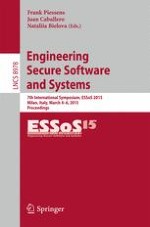2015 | Buch
Engineering Secure Software and Systems
7th International Symposium, ESSoS 2015, Milan, Italy, March 4-6, 2015. Proceedings
herausgegeben von: Frank Piessens, Juan Caballero, Nataliia Bielova
Verlag: Springer International Publishing
Buchreihe : Lecture Notes in Computer Science
